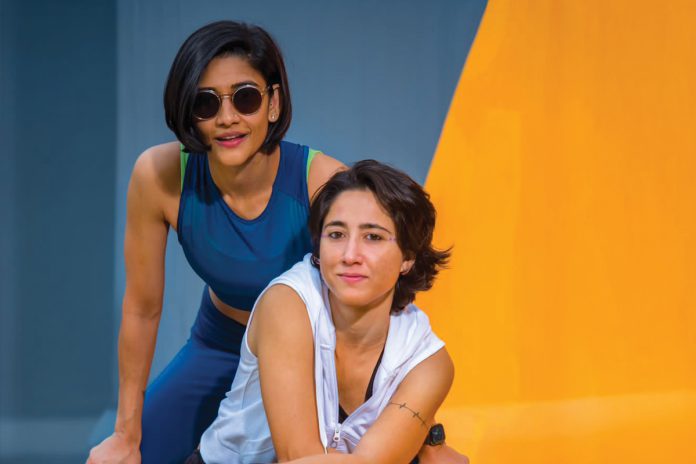We chat with the catchily named Sisters in Sweat to understand how women can uplift each other through the power of sport and wellness
Words by Charudatt Chindarkar
Your community specifically focuses on women in sports. What gaps in the existing sports ecosystem did you identify that led to creating this specialized space?
Some of the gaps/ barriers we identified that lead to the creation of Sisters in Sweat are as follows:
- Safety concerns: Women often face issues like harassment, lack of security during training or travel, and unsafe facilities.
- Societal expectations: Traditional gender roles and societal norms discourage many women from participating in sport.
- Unequal opportunities: Male athletes often receive more opportunities to participate in events, leagueand tournaments.
- Shortage of Women Coaches: There are very few female coaches and mentors, which creates a gap in gender-sensitive coaching.
Tanvie, having played football both in India and internationally, what structural differences have you observed in how women’s sports are supported, and how does Sisters in Sweat address these disparities?
There are two big differences that immediately come to mind. First is ‘access’ to organised sport for women, at the professional or recreational level, especially after they’ve graduated from school or college. This would constitute the limited sports infrastructure, coaching sessions of good quality, and generally safe and hygienic spaces for women to play.
Second is the ‘consistency’ in the access to organised sport. Simply having a place to train regularly through the year, with a team or group of women.
Our core offering at Sisters In Sweat is providing sport to women of all ages, consistently and intentionally, throughout the year. If 3 women turn up or 20, we turn up! So if you decide to start playing with us today, and return 8 months later, we’ll still be around, with quality coaching, an awesome community of women, in a safe and encouraging environment.
How do you balance making sports accessible to beginners while also creating pathways for serious athletes? What role does this play in building a more inclusive sports culture?
There are few ways by which we believe we can do this:
Multi-Level Programming: Offering tiered programs or leagues (e.g., beginner, intermediate, advanced) allows participants to engage at their own skill level. Beginners can focus on learning fundamentals without feeling intimidated, while serious athletes can pursue higher levels of competition. This ensures everyone feels welcomed and supported, regardless of their skill level, fostering a sense of belonging.
Emphasizing Fun and Fundamentals for Beginners:
For beginners, the focus should be on skill-building, teamwork, and enjoyment rather than immediate competition. This creates a low-pressure environment where people can build confidence.
Creating Clear Pathways for Development : Providing structured opportunities to progress from beginner to advanced levels—such as training programs, mentorship, and exposure to competitive experiences—ensures athletes with potential can advance.
Swetha, as a fitness coach working with diverse clients, how do you address cultural and social barriers that might prevent women from participating in sports and fitness activities?
As a fitness coach working with diverse clients, it’s important to take a sensitive and inclusive approach to address cultural and social barriers that might prevent women from participating in sports and fitness activities.
Here are some strategies I employ:
Creating a Safe and Inclusive Environment: Ensuring that women feel comfortable in the gym or fitness space is vital. This includes having women-only classes or designated spaces that cater to modesty preferences and making sure the environment feels non-judgmental. It’s important that all clients, regardless of background, feel supported and accepted.
Breaking Down Social Stigma: Some women may face social stigma around participating in fitness activities, particularly in more traditional or conservative environments. I’d focus on empowering these clients by emphasizing the personal benefits of fitness, such as health, strength, and self-confidence, while addressing any concerns they may have about societal judgment.
Role Models and Representation: I would highlight female role models from diverse backgrounds who have overcome similar challenges and have succeeded in sports or fitness. Representation is a powerful tool in inspiring others to break barriers.
Family and Community Engagement: For some women, family approval and community support are crucial. I’d encourage a broader community approach by engaging with family members or support networks to help them understand the benefits of physical activity for women and how they can encourage participation.
Education and Awareness: Educating women on the health and wellness benefits of fitness can help shift cultural and social norms. I would share evidence-based information on how fitness can improve mental health, reduce stress, and increase overall well-being, empowering them to view fitness as a valuable part of self-care.
By fostering an environment of respect, understanding, and empowerment, one can help women navigate these barriers and make fitness an accessible and enjoyable part of their lives.
What role do you see organizations like Sisters in Sweat playing in creating sustainable change in sports policy and infrastructure development for women?
Through community-building, strategic partnerships, and advocacy for inclusive policies, SIS is actively contributing to the development of sustainable sports infrastructure and empowering women to reclaim their space in sports.
By fostering a women-only community, SIS creates safe, inclusive spaces where women can engage in various sports and physical activities without societal constraints. This initiative not only promotes physical well-being but also challenges long-standing cultural norms that often discourage women from pursuing sports.


